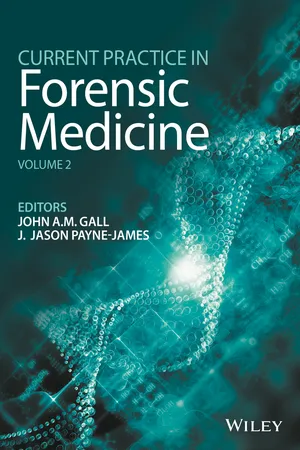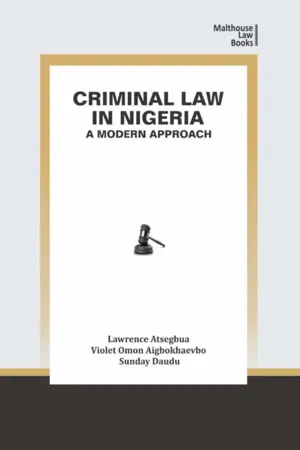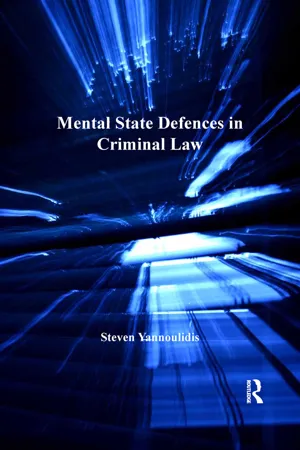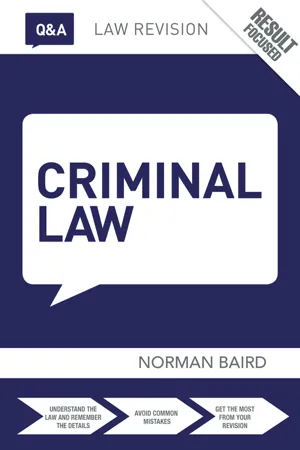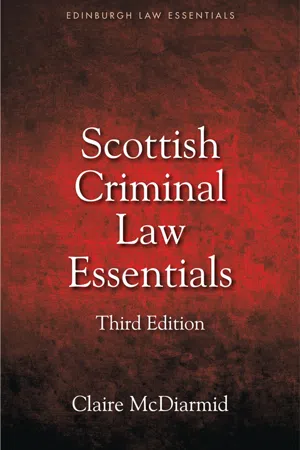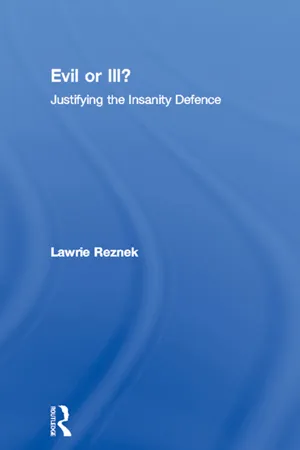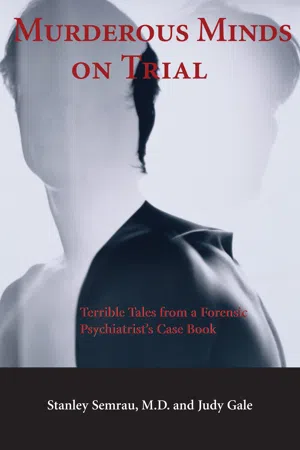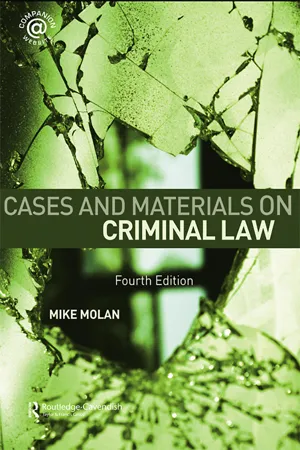Law
Automatism defence
The automatism defense is a legal concept that can be used to argue that a person's actions were involuntary due to a state of automatism, such as sleepwalking or a seizure. If successfully argued, it can result in the acquittal of the individual, as they are not held responsible for their actions. This defense hinges on the lack of voluntary control over one's actions.
Written by Perlego with AI-assistance
Related key terms
1 of 5
11 Key excerpts on "Automatism defence"
- eBook - ePub
- John A. M. Gall, Jason Payne-James, John A. M. Gall, Jason Payne-James(Authors)
- 2016(Publication Date)
- Wiley-Blackwell(Publisher)
Most criminal offences require that the defendant’s acts or omissions are voluntary. The defence of automatism is a common law defence to all crimes. It is available where the defendant has performed an act or made an omission but in the absence of such voluntariness. According to Yannoulidis (2012): ‘Automatism refers to an individual’s lack of control for his or her conduct resulting in him or her acting in an unwilled fashion. It is an individual’s lack of volition which gives rise to automatism.’Examples of automatisms range from sneezing, as in the case of R v Woolley [1998] CLY 914, where a driver had a sneezing fit causing a seven‐car pile‐up, to confusional states lasting several months, as in a case of cerebral tumour (Ebrahim, Fenwick, Marks and Peacock, 2005).Definitions of automatism
Medical
Fenwick (1996) has proposed the following definition of automatism:An automatism is an involuntary piece of behaviour over which an individual has no control. The behaviour is usually inappropriate to the circumstances, and may be out of character for the individual. It can be complex, coordinated, and apparently purposeful and directed, though lacking in judgement. Afterwards the individual may have no recollection or only partial and confused memory for his actions.Legal
There are numerous legal definitions of which the following is a representative selection:- [A]ction without conscious volition. (Gresson P, in R v Cottle [1958] NZLR 999)
- [A]ction without any knowledge of acting, or acting with no consciousness of what is being done. (Gresson P, in Cottle)
- [A]n involuntary movement of the body or limbs of a person following complete destruction of voluntary control. (Watmore v Jenkins [1962] 2 QB 572)
- [A]n act which is done by the muscles without any control by the mind such as a spasm, a reflex or a convulsion; or an act done by a person who is not conscious of what he is doing. (Denning LJ, in Bratty v A‐G for Northern Ireland
- eBook - PDF
- Lawrence Atsegbua, Violet Aigbokhaevbo, Sunday Daudu(Authors)
- 2022(Publication Date)
- Malthouse Press(Publisher)
25 Per Ogbuagu, J.S.C. observed: However, the appellant had thought, foolishly I may say, that the defence of alibi would conclusively avail him. But the said alibi was not only watery but was bogus in the extreme…The trial court rightly, in my view, rejected the said plea or defence of alibi. AUTOMATISM AUTOMATISM AUTOMATISM AUTOMATISM Automatism means a behaviour performed in a state of mental unconsciousness or dissociation without full awareness. The term is applied to actions or conduct of an individual apparently occurring without will, purpose, or reasoned intention on his part, a condition sometimes observed in persons who without being actually insane, suffer from an obscuration of the mental faculties, loss of volition or of memory, or kindred affections. Automatism may be asserted as a defence to negate the requisite mental state of voluntariness for commission of a crime. Again, “Ambulatory automatism” describes the 24 (2006) 15 NWLR (pt 1000) 352 25 See also the decision in Queen v. Turner (1957) WRNLR 34 and Yanor v. The State (1965) NMLR 337. Accident 267 pathological impulse to purposeless and irresponsible wandering from place to place often characteristic of patient suffering from loss of memory with dissociation of personality. 26 As earlier noted, by virtue of section 24 of the Criminal Code, a person is not criminally responsible for an act or omission which occurs independently of the exercise of his will or for an event which occurs by accident. Fundamentally, there are two arms in the above section. These are: (a) a person is not criminally responsible for an act or omission which occurs independently of the exercise of his will; and (b) a person is not criminally responsible for an event which occurs by accident. It is plain that section 24 provides for two types of defences. In the one labelled (a) above, the accused person would have acted or omitted to act under a condition which is involuntary. - eBook - PDF
- Alec Buchanan(Author)
- 2000(Publication Date)
- Jessica Kingsley Publishers(Publisher)
51 Thus if the defendant wishes to rely on a defence of automatism, and if he can persuade the court that the automatism had an external cause, such as a blow to the head, it is then for the prosecution to satisfy the jury, beyond reasonable doubt, that his actions were not automatic. If, on the other hand, the purported automatism has an internal cause, such as his epilepsy, then it is for the defendant to prove to the jury, on the balance of probabilities, that, to use the words of Lord MacDermott, ‘the mind did not go with what was done’. In the United States, the usual practice has similarly been to incorporate certain forms of automatism into the insanity defence. The criterion for such inclusion has usually been the likelihood of recurrence. 52 Some debate has surrounded the jurisprudential status of automatism. The implication in the Model Penal Code is that it operates by denying that the defendant could have possessed the necessary mens rea for the crime (American Law Institute 1985, Sections 1.13, 2.01). As noted above (see p.97), this is not the view taken by most English writers, who have held that the voluntariness of the act is an aspect of the actus reus . Other American authorities also dispute the Code’s assumption, asserting that an automatic actor commits no crime not because he lacks mens rea but because he has not engaged in ‘an act’, this being defined in its turn as a ‘voluntary bodily movement’ (LaFave and Scott 1972, p.338). Theoretically at least, the distinction is of some importance. If automatism denies the actus reus then it is possible for the automatic actor to be found not guilty of crimes of strict liability (see Chapter 1, endnote 1). This is not the case if automatism denies the mens rea . To what extent do the legal definitions of automatism described here corres-pond with those provided by the medical texts? In general, use of the term is very similar. - eBook - ePub
- Steven Yannoulidis(Author)
- 2016(Publication Date)
- Routledge(Publisher)
The first section will outline the nature of the common-law doctrine of automatism. This in turn will be followed by the drawing of a distinction between instances of automatism going to voluntariness and those instances which are subsumed by the insanity defence. The final section will highlight several difficulties faced by the criminal law in respect of the correct characterization of states of automatism.Lack of volition
Automatism refers to an individual’s lack of control of his or her conduct resulting in him or her acting in an unwilled fashion.125 It is an individual’s lack of volition which gives rise to automatism. Cases that have been recognized as giving rise to a lack of voluntariness include instances of concussion caused from a blow to the head,126 somnambulism,127 extreme stress,128 epilepsy129 and certain physiological states.130 Certain cases and commentators have suggested that it is an accused’s lack or altered state of consciousness which is the defining feature of automatism.131 This focus on an accused’s consciousness has in turn led to calls for automatism to be subsumed, along with the defence of insanity, within a general defence of mental disorder.132 For now I simply note this view and will return to it in Chapter 6 .In both Australia and Canada, another line of authority indicates that it is the absence of volition, rather than consciousness, which is the defining feature of automatism.133 Lord Denning, in the House of Lords decision of Bratty v A-G (Northern Ireland), 134 held that ‘automatism [means] an act which is done by the muscles without any control by the mind, such as a spasm, a reflex action or a convulsion’.135 Barwick CJ in Ryan v R 136 noting Lord Denning’s remarks in Bratty 137 approvingly, held that the term ‘automatism’ was merely a ‘convenient expression … to comprehend involuntary deeds where the lack of concomitant or controlling will to act is due to diverse causes’.138 His Honour held that the real issue in regard to automatism is whether an exercise of will is absent, not whether there is a lack of consciousness on the part of the accused. In the words of the judgment: ‘It is of course the absence of the will to act or, perhaps, more precisely, of its exercise rather than lack of knowledge or consciousness which … decides criminal liability’.139 Similarly, the Canadian Supreme Court has held that ‘voluntariness, rather than consciousness, is the key legal element of automatistic behaviour since the defence of automatism amounts to a denial of the voluntariness component of the actus reus’. 140 Courts in these jurisdictions have been prepared to accept that a degree of consciousness, or awareness, will not preclude a finding of automatism.141 - eBook - ePub
- Norman Baird(Author)
- 2014(Publication Date)
- Taylor & Francis(Publisher)
Typical examples are sleepwalking, acts done in a hypnotic trance, reflex actions and convulsions. Such states normally excuse a defendant for his conduct and its consequences on the basis that no responsibility can fairly attach to unwilled actions. However, the ‘defence’ is limited in application and does not always result in a complete acquittal. Its availability may be limited by requiring a total loss of control. In addition, the causes of the condition must be considered. If automatism is the result of an internal condition that is likely to result in recurrent ‘malfunctioning’, the defendant is legally insane and entitled only to a qualified acquittal. Or if there is prior fault on the part of the defendant either because he is voluntarily intoxicated or has ‘recklessly’ failed to take steps to prevent himself falling into a state of automatism his condition will not excuse all crimes. 1 Total Loss of Control In Attorney General’s Reference (No 2 of 1992) (1993), the Court of Appeal held that automatism is only available where there was a complete destruction of voluntary control. The defendant, a lorry driver, was charged with causing death by reckless driving. He raised a defence of automatism and produced expert evidence that the repetitive visual stimuli experienced as he drove along the straight, flat, featureless motorways had induced a trance-like state. The judge allowed the defence to go before the jury and the defendant was acquitted. The prosecution appealed, successfully. The Court of Appeal held that as there had not been a total destruction of voluntary control the judge ought not to have allowed the defence of automatism to go to the jury - eBook - PDF
- Claire McDiarmid(Author)
- 2017(Publication Date)
- EUP(Publisher)
• For the purposes of establishing the defence, the accused must be regarded as an ordinary sober person of reasonable firmness but, otherwise, as having all of his or her own characteristics. Neither excessive courage nor excessive timidity will be taken into account just because the accused in fact possesses these characteristics. • The defence of necessity is available in relation to all crimes. The accused must have been subjected to a threat of immediate danger of death or great bodily harm, whether to herself or to a companion and whether at the hands of another person or from natural or medical causes. If there is a viable alternative course of action which is also legal then the defence will fail. The defence cannot be used once the danger has ceased. The defence can be used only where the accused has weighed up the undesirability of committing the crime against the danger which will be averted by acting illegally. • It is a complete defence to any charge that the accused is aged 7 or under. (This threshold is due soon to be raised to 11.) DEFENCES 67 Essential Cases Ross v HM Advocate (1991) : automatism is established where the accused suffers a total alienation of reason caused by an external factor which was neither self-induced nor foreseeable. Sorley v HM Advocate (1992) : direct evidence must be led in order to satisfy all four of the tests set down in Ross before automa-tism is established. Cardle v Mulrainey (1992) : if the accused retains any rational control or understanding of his or her actions, the alienation of reason is not total and the defence of automatism will be unsuccessful. Ebsworth v HM Advocate (1992) : an adverse reaction to legal drugs used according to instructions may ground a defence of automatism. Thomson v HM Advocate (1983) : coercion requires an immediate threat of danger of death or great bodily harm and an inability to resist that violence. - eBook - ePub
Evil or Ill?
Justifying the Insanity Defence
- Lawrie Reznek(Author)
- 2005(Publication Date)
- Routledge(Publisher)
5AUTOMATISM AS AN EXCUSEAN INSANE LAWThe legal definition of automatism was given by Viscount Kilmuir in Bratty’s Appeal:[I]t means unconscious, involuntary action, and it is a defence because the mind does not go with what is being done … This is very like the words of the learned President of the Court of Appeal of New Zealand in Reg. v Cottle where he said: ‘With respect, I would myself prefer to explain automatism simply as action without any knowledge of acting, or action with no consciousness of doing what was being done.’(Fenwick, 1990: 273) This makes the excuse of automatism identical to the excuse of ignorance, which seems sane enough.Of course, while the excuse of automatism amounts to the excuse of ignorance, this is not to say that automatism is simply a matter of acting in ignorance. In ordinary cases of ignorance the person is aware that he is performing some action, although not under the description he believes. For example, Fred believes he is administering penicillin, while in fact he is poisoning his mother. But the person with an automatism is unaware that he is acting at all, under any description. He is not just ignorant of what he is doing; he is unaware. Nevertheless, this is a sort of (more radical) ignorance, and nothing more is needed to enable it to qualify as an excuse.English law distinguishes two types of automatism: sane and insane. Sane automatism occurs when the mind is disordered by an external factor like an injection of insulin or a blow to the head, and an insane automatism occurs when the cause is an intrinsic factor that is prone to recur and may lead to violence. This distinction is absurd, as Fenwick (1990: 275) points out:For a violent act committed while the mind is disordered owing to an excess of insulin is a sane automatism if the insulin is injected, but an insane automatism if the insulin comes from an insulinoma of the pancreas. The distinction between sane and insane automatism is a meaningless one, and if the legal profession could bring itself to do so, it is probably best abandoned altogether. - eBook - ePub
Murderous Minds on Trial
Terrible Tales from a Forensic Psychiatrist's Casebook
- Stanley Semrau, Judy Gale(Authors)
- 2001(Publication Date)
- Dundurn Press(Publisher)
Rabey’s defence against an attempted murder charge was based on “psychological blow automatism.” The shock of reading the young woman’s letter and learning her true feelings sent the spurned suitor into a dissociative state, a defence expert claimed, and therefore the assault was the unconscious and involuntary act of an automaton. A psychiatrist called by the prosecution, however, claimed that Rabey had attacked her in a state of rage—an uncharacteristic state of mind for Rabey, but not an abnormal one in terms of awareness of reality and one’s actions. He could therefore have formed the intent to kill or cause serious bodily harm, and must have known by the amount of blood alone that he was striking her, and that he had badly injured her.The defence of automatism succeeded, and Rabey was acquitted. However, the verdict and a number of related issues remain controversial today. Automatism is, in my opinion, the flakiest of legal-psychiatric concepts. The idea of a mind unaffected by illness or injury having no idea what its body is doing has no basis in modern psychiatry, psychology or neurology.We can’t say that the mental state of killers or would-be killers is normal. People in a state of rage focus narrowly on their immediate situation and can act on short-sighted impulse, doing things they would never do when calm, and which they deeply regret afterwards. But some substantial part of their mind is still executing intentional acts.The Canadian Psychiatric Association is on record with the House of Commons Justice Committee as recommending abolition of this defence. “When it is said that the accused functions as an automaton,” the 1992 CPA brief said, “it is meant that the body acts independently and separately from the mind. Such an assumption is erroneous. The behaviour and the function of the body is always governed by the mind, whether normal or disordered. . . . The concept of . . . a factor ‘external’ to the mind affecting the mind, cannot be supported.”But the defence still stands, and it remains attractive because of its potential for complete acquittal. Paradoxically, we wind up basing the most extreme outcome (freedom if the defence succeeds) on the flimsiest of concepts and evidence. Most medical experts approach a claim of automatism with skepticism.Clark Kent’s lawyer called upon my colleague Dr. Q. and forensic psychologist Dr. F. to test and assess the accused. Both found him—as I had—open, honest, intelligent, sociable, aware, conservative, respectful, and eliciting no signs of any mental disturbance. They felt that he had been slightly depressed in the months leading up to the shooting, with feelings of helplessness and lowered self-respect in the face of the hostile aggressiveness he was subjected to from his neighbour. - eBook - ePub
Cases & Materials on Criminal Law
Fourth Edition
- Mike Molan(Author)
- 2009(Publication Date)
- Routledge-Cavendish(Publisher)
The defendant strangled a young woman whilst suffering from an attack of psychomotor epilepsy. The House of Lords considered whether this could be regarded as a case of sane automatism, or whether it was more appropriate to regard it as falling within the scope of insanity (i.e. insane automatism).Lord Denning:No act is punishable if it is done involuntarily; and an involuntary act in this context – some people nowadays prefer to speak of it as ‘automatism’ – means an act which is done by the muscles without any control by the mind, such as a spasm, a reflex action or a convulsion; or an act done by a person who is not conscious of what he is doing, such as an act done whilst suffering from concussion or whilst sleep-walking. The point was well put by Stephen J in 1889: ‘Can anyone doubt that a man who, though he might be perfectly sane, committed what would otherwise be a crime in a state of somnambulism, would be entitled to be acquitted? And why is this? Simply because he would not know what he was doing’; see R v Tolson (1889) 23 QBD 168, 187. The term ‘involuntary act’ is, however, capable of wider connotations: and to prevent confusion it is to be observed that in the criminal law an act is not to be regarded as an involuntary act simply because the doer does not remember it. When a man is charged with dangerous driving, it is no defence for him to say ‘I don’t know what happened. I cannot remember a thing’; see Hill v Baxter [1958] 1 QB 277. Loss of memory afterwards is never a defence in itself, so long as he was conscious at the time; see Russell v HM Advocate [1946] SC (J) 37; R v Podola [1960] 1 QB 325. Nor is an act to be regarded as an involuntary act simply because the doer could not control his impulse to do it. When a man is charged with murder and it appears that he knew what he was doing, but he could not resist it, then his assertion ‘I couldn’t help myself’ is no defence in itself; see AG for South Australia v Brown [1960] AC 432: though it may go towards a defence of diminished responsibility, in places where that defence is available; see R v Byrne [1960] 2 QB 396: but it does not render his act involuntary so as to entitle him to an unqualified acquittal. Nor is an act to be regarded as an involuntary act simply because it is unintentional or its consequences are unforeseen. When a man is charged with dangerous driving, it is no defence for him to say, however truly, ‘I did not mean to drive dangerously’. There is said to be an absolute prohibition against that offence, whether he had a guilty mind or not; see Hill v Baxter [1958] 1 QB 277 at 282 by Lord Goddard CJ. But even though it is absolutely prohibited, nevertheless he has a defence if he can show that it was an involuntary act in the sense that he was unconscious at the time and did not know what he was doing, see HM Advocate v Ritchie 1926 SC (J) 45, R v Minor (1955) 15 WWR (NS) 433 and Cooper v McKenna ex p Cooper - eBook - ePub
- Rodger Geary(Author)
- 2012(Publication Date)
- Routledge-Cavendish(Publisher)
Chapter 8General DefencesInsanityWhere the defendant claims to have been suffering at the time of the offence from some sort of mental disturbance or impairment, then automatism, insanity and, in murder cases, diminished responsibility may all be considered. Automatism, a condition which consists of the body operating without the control of the mind, has been discussed in Chapter 2 and diminished responsibility in Chapter 5 . It should be noted that insanity unlike automatism will not provide a defence to crimes of strict liability (DPP v H (1997)).Although insanity may also be an issue where the defendant has been remanded in custody, or at the beginning of the trial itself, most undergraduate courses concentrate on insanity in relation to the defendant’s mental state at the time of committing the offence. It is insanity as a defence at the trial which is discussed here.DefinitionIn 1843, Daniel M’Naghten, intending to murder Sir Robert Peel, killed his secretary by mistake. Following his acquittal on grounds of insanity, the judges formulated the so called M’Naghten rules which have since become accepted as providing a comprehensive definition of insanity (R v Sullivan (1984)).According to these rules, it must be proved (by the defence, on a balance of probabilities) that, at the time the offence was committed, the defendant was labouring under such a defect of reason, arising from a disease of the mind, so as not to know the nature and quality of the act he was doing, or, if he did know it, that he did not know that what he was doing was wrong.The Nature and Quality of the ActAs we have noted, one of the two grounds for establishing insanity under the M’Naghten rules is that the defendant’s disease of the mind prevented him from being aware of his actions. For example, in R v Kemp - eBook - ePub
- Tony Storey, Alan Lidbury(Authors)
- 2012(Publication Date)
- Willan(Publisher)
The position, presumably, is different when there is an extraordinary stress. The shock of seeing a loved one murdered, for example, could cause a dissociative state in anyone. Consequently, where an event is deemed, objectively, to be extraordinary, then this qualifies it as an external cause entitling D to an acquittal. This seems to be the explanation of the decisions in T (1990) and Falconer (1990), considered in Chapter 16. In Falconer, the High Court of Australia distinguished mental states which ‘may be experienced by normal persons’, from those which are ‘never experienced by or encountered in normal persons’. The former implies sane automatism, the latter insanity. Rather than concentrating exclusively on whether the cause was internal or external, the Court suggested a radical, new distinction, between the reaction of: a sound mind to external stimuli including stress (sane automatism); and an unsound mind to its own delusions or to external stimuli (insane automatism). Rabey was followed by the Supreme Court of Canada in Stone (1999), where D pleaded automatism to the murder of his wife. D’s evidence was that he had experienced a ‘whoosh sensation’ washing over him after his wife had insulted him, during which he stabbed her 47 times. The trial judge held that, if anything, this was a defence of insanity. D was convicted of manslaughter and appealed. The Supreme Court held that the trial judge was correct. Bastarache J said that ‘evidence of an extremely shocking trigger will be required to establish that a normal person might have reacted to the trigger by entering an automatistic state, as the accused claims to have done’. ‘Disease of the mind': a summary On the whole, the courts in England have restricted the Automatism defence. The defendant who pleads automatism based on epilepsy, diabetes or even sleepwalking faces being labelled as insane. This is perhaps justifiable where D has committed acts of violence
Index pages curate the most relevant extracts from our library of academic textbooks. They’ve been created using an in-house natural language model (NLM), each adding context and meaning to key research topics.
